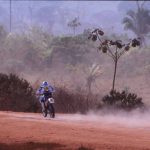
SUPERMOTO IMPRESSION: 2025 SUZUKI DR-Z4SM
THE SUZUKI DR-Z’S NOT-SO-EVIL TWIN – OCTOBER 2025 ISSUE
Our experience with the DR-Z4SM on the K1 Circuit karting track was a blast, but we had no idea what we were doing.
“Yes, but is it a dirt bike?” That’s the question that we always ask when it comes to Supermoto bikes. No one really answers, so we usually take them into the dirt to find out for ourselves.
The new Suzuki DR-Z4SM is, we decided, a dirt bike with big street bike wheels, tires and brakes. Simple enough. It’s the stablemate to the DR-Z4S dual-sport bike that we tested in the August issue. That bike was a very big deal to us because it was the first new Suzuki that we had tested in years. Contrary to all the experts on social media, Suzuki is a very healthy company and isn’t going anywhere. They just backed out of the year-to-year development race that was required in the motocross world. The new DR-Z pair shows that Suzuki can still design, build and develop a new bike if the company’s upper brass thinks it’s important enough. And, as it turns out, Suzuki still knows how to make a good motorcycle.
HOW NEW IS IT, REALLY?
Suzuki took an odd road on its way to the revitalization of the DR-Z line. Clearly, the two bikes are not new from scratch; they bear a very strong resemblance to the DR-Z400S from 25 years ago. But, virtually every single part was designed from scratch. Nothing is interchangeable. The new motor is fuel-injected with twin spark plugs, and it has a catalyst in the head pipe for a cleaner burn. That, obviously, is the main point behind the bike. Suzuki uses fleet-emissions averaging to please the EPA, and the old carbureted DR-Z was dragging down the whole line. Once given the budget to update the DR-Z to a cleaner state of tune, the enthusiasts within the company went the extra mile to update everything. It now has a perimeter frame, an inverted fork and current ergonomics. Plus, it now has electronic riding aids similar to those in the adventure bike world. It comes with anti-lock braking, which can be disabled with the push of a button, three maps for power output and four levels of traction control.
The main differences between the dual-sport version and the SM are the wheels, brakes, suspension and mapping. The SM has massive 17-inch street tires on both ends. The front brake is upped to a 310mm rotor and the suspension travel is reduced into the 10-inch range.
Suzuki gave the DR-Z4SM a price identical to that of the dual-sport version: $8999.
The main reason that the DR-Z line was redesigned was to give it fuel injection. If nothing else, we’re delighted to say goodbye to the CV carb from the original DR-Z400S.
TRACK TIME
Suzuki arranged for us to ride the DR-Z4SM on the new K1 Circuit karting track in Winchester, California. We were the first motorcycles to ride there, and to be fair, it didn’t yet have a dedicated Supermoto track with off-road obstacles. We were strictly on the pavement, which placed us a little outside of our comfort zone.
We have only dabbled in the art of sliding a motorcycle on the pavement, but we know this: it’s a blast. There were two factors that made it more difficult for us at K1 Circuit. First, the pavement was so new that traction was far greater than anything we had previously experienced. The grip between the Dunlop Sportmax tires and the tarmac was unreal. On top of that, the DR-Z4SM is no race bike. The power delivery is smooth, but it has no big hit, and peak output is only in the vicinity of 35 horsepower. After a while, though, it started to click. The Suzuki isn’t going to break loose from sheer power. But, with traction control and anti-lock turned off, it will slide coming into turns, and that allows for a smooth arc all the way to the exit. The clutch has a slipper cam to reduce plate pressure during engine braking, so you could bang down shifts hard coming into turns.
We also know from our experience with the dual-sport version that Suzuki’s traction control system is actually quite useful in the dirt. In mode “G” (for gravel) it allows limited, controllable wheelspin. It’s smooth and unintrusive. This is far more practical than most adventure bike TC systems, which act like an invisible thumb on the kill switch. Mode G would be essential for taking the SM off-road, whether or not it’s part of a Supermoto course.
Remember Supermoto? The Suzuki DR-Z4SM makes us want it back!
The SM’s display is identical to that of the dual-sport version and provides instant info on mapping, traction control, and anti-lock modes.
The 310mm front rotor gives the DR-Z4SM essential braking power for the pavement. It’s eye-opening how weak traditional off-road brakes feel when you transition to asphalt.
We rode the DR-Z4SM about 100 miles on mountain roads prior to riding the track. Just as we discovered when we rode the dual-sport versions, it could really use a sixth gear.
BRING BACK SUPERMOTO!
About 15 years ago the AMA Pro Supermoto Championship vanished, although there are small enclaves where the sport still exists in the U.S. The DR-Z4SM makes us want it back. No, it’s not a race bike, but we would love to see a spec class where stock Suzukis go bar to bar.
In the meantime, the SM version and the dual-sport version of the DR-Z can exist side by side and offer an interesting choice. You can have two bikes in one with the purchase of an extra set of wheels. The question is, do you start with the dual-sport for its increased suspension travel or the SM for the larger front brake? From our brief experience with the SM, we found that most of the other differences between the two are less significant. For us, we still prefer the dual-sport, but when Supermoto comes back, wheel makers like Dubya will be our first call.











